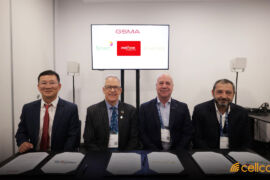
1997 – four years after Cambodia regained its full sovereignty, the country was still wading the waters to recovery. It was a tumultuous time as the country dealt with the aftermath of the Khmer Rouge, nursed the trauma of a generation, and was caught between a political struggle – that which will define Cambodia as we know it today. 1997 marked the beginning of many things, which has all led us here; bringing about peace, stability and stellar economic growth that has put Cambodia on the map as one of the world’s fastest growing economies. It also marked the beginning of the country’s telecommunications development.
In 1993, Cambodia was regarded as the 1st country in the world where mobile telephone subscribers surpassed fixed-lines/ wireless fixed-lines at 81% vs. 19%. This was documented in a 2002 report by the International Telecommunications Union (ITU Geneva Switzerland).
Analogue mobile cellular service was introduced in Oct 1992 by Cambodia Mobile Telephone Company (CamTel). Other providers followed suit. Cambodia Samart Communications (Casacom) – a joint venture between Samart Thailand, Telkom Malaysia and the Cambodian government in November 1992, Tricelcam – a joint venture between Tri of Malaysia and the Cambodian government in October 1993, and Cambodia Shinawatra (Camshin) – a subsidiary of the Shinawatra Group Thailand in 1998.
But it was the launch of GSM that propelled the telecommunications development, and one company rose to the fore – CamGSM Co. Ltd. Originally a joint venture between the Luxembourg-based Millicom and the Royal Group of Cambodia, CamGSM Co. Ltd. was the first to launch a GSM network (Mobitel) in March 1997. Combined with the launch of the country’s first prepaid service (CELLcard) and first nationwide coverage in 1998, the company took market leadership within one year of launch. By year 2000 it had 70% market share of the entire Cambodian telecom market.
“Launching a prepaid service on the back of nationwide coverage fueled the telecommunications development of Cambodia. Before then, operators were offering postpaid service, and cellular connectivity was limited to the government and the elite who can afford. The vision then was to connect the country; connectivity for all, which at that time was desperately needed to drive not only the dissemination of information, but to support the community, nurture the economy and rebuild civilization after decades of war. Prepaid made cellular connectivity more inclusive by providing more affordable services for more Cambodians. During the early 1990s, Cambodia was one of the poorest countries in the world with 36% of the population living below the poverty line. It was of utter importance for us to provide services for the general mass audience, both from a development standpoint as well as from a business perspective.” – Neak Okhna Kith Meng, Chairman of the Royal Group of Companies.
In the following years, the brand dominated the market with multiple roll outs of first-to-market innovative services which included SMS (2001), Roaming via Tele2 (2002), MMS, Streaming, Calltunes, Unlimited Downloads, and Cambodia’s first 3G network (2005), all of which opened a whole new world of relevance for the category, and launched the brand to even greater heights.
“In 2004 we started building the brand on the back of “Best Quality Conversations” hinged on the quality of the service and catering to the needs of consumers to be plugged in, connected, and at the center of everything that matters. We adhered to the idea of belonging, and presented the importance of being connected to friends, family and the community, all the while reinforcing the brand’s promise on quality service, best price, and being first to market on innovations/VAS. The tagline “Clearly Cellcard” was an affirmation of choice as well as a quality assurance. –
Neak Okhna Kith Meng, Chairman of the Royal Group of Companies.
The development of the telecommunications industry, compounded with government efforts to liberalize the market led to multiple entrants all vying for market share. By 2007 there were 4 players including CamGSM Co. Ltd, Hello (Telekom Malaysia International), Mfone (Thaicom Group), and Star-Cell (TeliaSonera). 2008 saw the entrance of QB (CadComms), and Metfone (Viettel). Smart (Latelz) and Beeline (Sotelco Ltd.) followed suit in 2009. For a market the size of Cambodia, the telecoms industry was severely overcrowded. And stiff competition has plunged the industry into price war, which later led to consolidation as operators file for bankruptcy.
“It was a challenge. Operators had to be agile in their pricing to accommodate sudden shifts and reactions from competitors. Price points changed within days and weeks of launch, and given the number of players in the market during the time, moving the market share needle was hard work. Eventually, the Price war hit Cellcard, as it did all other operators. Operators started dropping out, filing for bankruptcy. The market went through a period of consolidation. A number of mergers; Smart and Star-Cell, Hello and Smart, Cellcard also took in Mfone. The brand’s proposition has been clear from the very beginning. It was hinged on quality and innovation not low price, but as we see the emergence of a new generation of users that demands for innovation and quality, I believe Cellcard will be in a prime position for growth moving forward.” –
Neak Okhna Kith Meng, Chairman of the Royal Group of Companies.
While overcrowding may lead to unfair competition, on hindsight what can be seen is a robust growth in mobile penetration through the years. The World Bank reports up to 21M mobile subscriptions in 2019 with mobile-cellular usage standing at 130 per 100 persons, compared to fixed-line connections at about 0.3 per 100 persons and declining.
Today 5 operators remain. The top three includes CamGSM Co. Ltd. (Cellcard), Smart Axiata and Viettel Metfone. Regarded as Cambodia’s ‘big three’, they account for 90% of total mobile subscribers in the Kingdom. Other operators include Cootel (Xinwei Telecom Co. Ltd.) and Seatel (South East Asia Telecom Co. Ltd.)

“Twenty-five years is not an easy feat for any brand, any company, especially for a local, privately-owned, single-market entity like Cellcard. It’s truly an amazing history and journey, and one that I am proud of. Innovation is the key to unlocking Cellcard’s growth potential, and that’s what we’ve been driving in recent years – first-to-market innovations that aspire to enrich the experiences of a new digital generation. Gaming and esports is the fastest growing industry in the world and has huge potential for the future not just for Cellcard but for Cambodia. Network quality and data speeds – this will be the driving force behind consumer choice especially with more and more digital devices, products and services that require quality connections. Cellcard will endure and moves forward with a renewed foundation, clear vision and a very capable team and leadership. –
Neak Okhna Kith Meng, Chairman of the Royal Group of Companies.
CamGSM Co. Ltd. (Cellcard) is currently the only 100% Cambodian-owned telecommunications operator, the longest-standing operator in the Kingdom and still one of Cambodia’s most respected brands.
“Cellcard’s history and heritage is uniquely its own, and it deserves to be highlighted and celebrated. The brand has lived through some of the most important years of Cambodia’s history, contributed to its development, and continues to service Cambodians everywhere up to this very day. It’s persistent existence and evolution, driven by its commitment to enable and enrich Cambodia’s connectivity through the years is awe-inspiring. I am honoured to be at the helm of this ship at such an important time. There is much work to do and challenges to overcome, but as the brand persisted through the years, so too will it persist now – for another 25 years and more. We are that process of recalibrating the brand and its priorities, simplifying and strengthening its focus to deliver innovations and impact like never before, and I look forward to continuing its legacy and launching the next line of innovations.” – Simon Perkins, Cellcard CEO 2021 – current

















